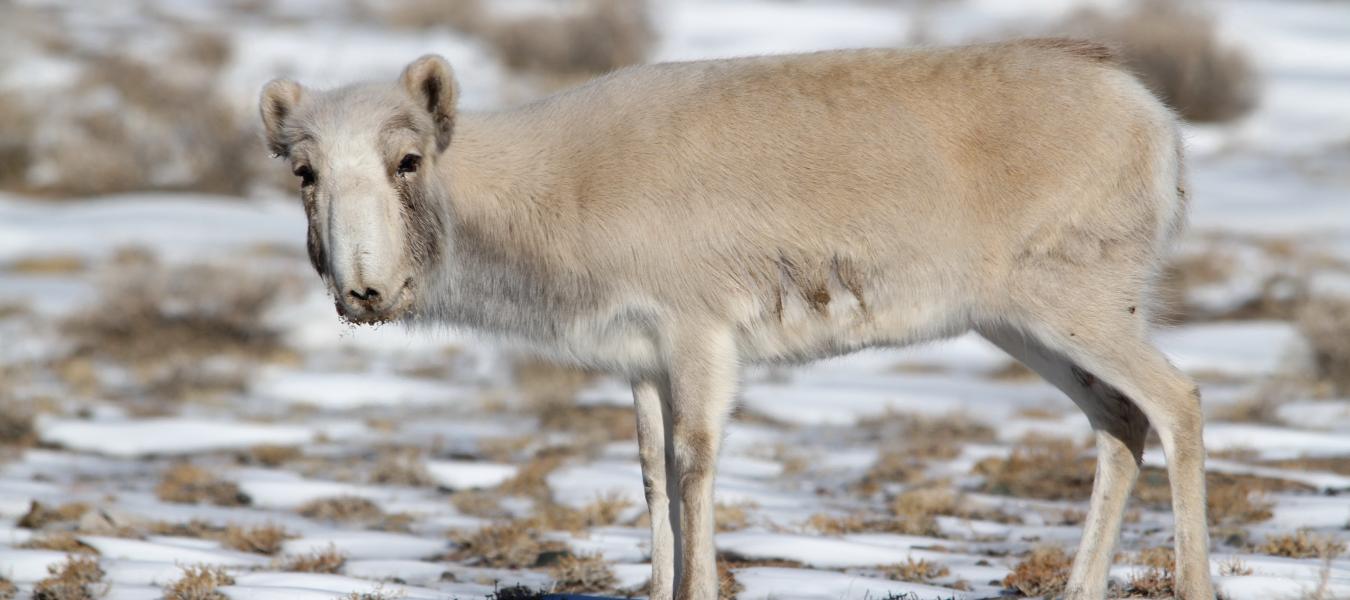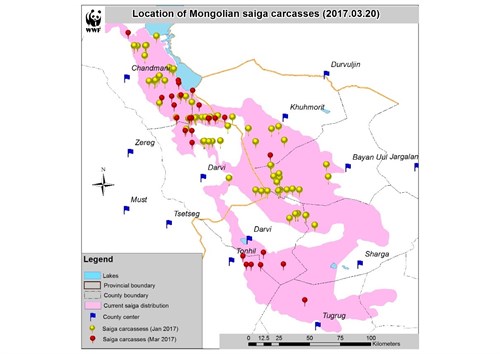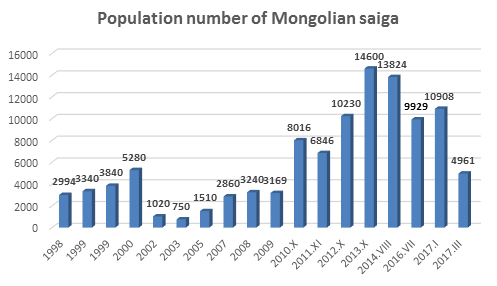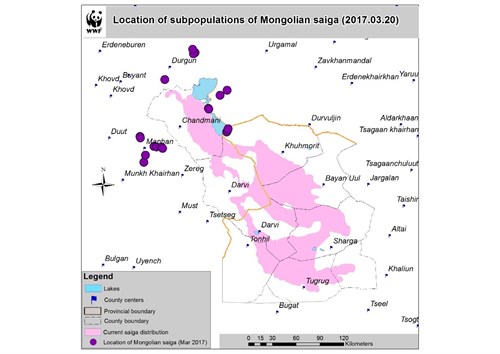
Situation analysis for the Mongolian saiga population, including the mass die-off due to an outbreak of goat plague
B .Chimeddorj1* and B. Buuveibaatar2
1 - Mongolia Program Office, World Wide Fund for Nature, Ulaanbaatar, Mongolia, 2 - Wildlife Conservation Society, Mongolia Program, Ulaanbaatar, Mongolia
*Corresponding author:Buyanaa Chimeddorj , chimeddorj@wwf.mn
The Great Lakes Depression in western Mongolia is the last refuge of the Mongolian Saiga (Saiga tatarica mongolica), a distinct endemic subspecies which once roamed between Eurasia and North America using the Bering Land Bridge. The subspecies now only inhabits the Shargiin Gobi, Khuisiin Gobi and Durgun valley, in the Great Lakes Depression of Western Mongolia (Amgalan et al., 2006). The total population size was 10,000 individuals in 2016, having increased over the past few years, after a population crash in the winter of 2001-2002, caused by a dzud (harsh winter), had left only 750 animals.

Sadly, the fate of the Mongolia saiga is currently again in jeopardy. An epidemic of peste-des-petits-ruminants (PPR), a viral disease of ruminants which can kill around 90% of infected animals, is currently ongoing. So far, the pathogen is spreading from the north-west to the south-east of the Mongolian saiga distribution and is already covering around 60-70% of the subspecies' range. Over 3,000 saigas were confirmed dead as of 6th February 2017. According to international experts, the mortality event is likely to continue in the coming months. The fact that the disease has not previously caused mass mortality of wild ungulates is surprising, and it may be that saiga antelopes are particularly vulnerable to the disease.

Assessment of the Mongolian Saiga's distribution, location and abundance was carried out from 13th to 20th March 2017. In order to compare the results with prior research findings, field research was conducted using the line transect method. The survey suggested that 4,961 saigas inhabited the saiga range (14,713 sq km) with a density of 0.34 heads per sq km. Compared to the survey in January 2017 (10,907 saigas estimated), the population has declined by 54.5% in the two months since the disease outbreak (Graph 1). During the March expedition, 65 carcasses were found, of which 43% were fresh, proving that individuals continue to perish (Map 1). Samples were taken from three saigas and three goitred gazelles and analysed by the State central veterinary laboratory; five of them tested positive for PPR virus. Although the intensity of mortality has reduced, this doesn't mean that the disease outbreak has halted, as virus was detected in the samples taken from Shargiin Gobi, which we had believed to be unaffected.
Since the saiga conservation programme started in 1998, its range has extended into the subspecies' historical range in Zavkhan region of Uvs province, Durvuljin region of Zavkhan province, Khukhmorit region of Gobi-Altai province and Durgun region of Khovd province. Field teams in these places estimated a total of 201 saiga individuals in fragmented populations. These are not counted in the overall population estimate. No symptoms of PPR were discovered during the field research (Map 2).

Key recommendations:
- Set up a quarantine area in the affected areas, increase control of irresponsible actions by livestock owners and enforce rules,
- Produce a simple and comprehensive information flyer on the Mongolian Saiga and disseminate it to households in the saiga's range,
- Protect rutting and calving areas, identify areas to be protected and develop protection regimes,
- Develop a strategy to save the Mongolian saiga through undertaking detailed DNA research on genetic capacity,
- Develop an action plan to be implemented after the disease outbreak has abated. Re-introduction of the Mongolian saiga to its historical range should be particularly considered ,
- Create favorable conditions for predator populations to grow within the range of the Mongolian saiga; prohibit hunting of gray wolves, red foxes and corsac foxes for a certain period,
- Enforce rules and regulations on appropriate pasture use.
Figure 1. Population size of the Mongolian saiga over time
Map 1. Location of Mongolian saiga carcasses found in the March expedition
Map 2. Location of the fragmented subpopulations of the Mongolian Saiga
